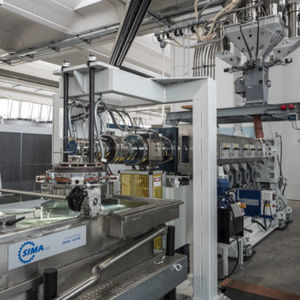
- Products
- Catalogs
- News & Trends
- Exhibitions
Mono-filament extrusion line TECHNO FIL-POLYSTEELfor HDPEfor PPfor PET


Add to favorites
Compare this product
Characteristics
- Type
- mono-filament
- Treated material
- for PP, for HDPE, for PET, for PA
Description
Technofil/Technopolysteel extrusion lines are the most advanced technological solution in the field of PP, HDPE, PA, PET monofilament production and it is designed for the manufacturing of twisted ropes, braided ropes, fishing nets, woven nets, industrial web, cables and , last but not the least, fiber concrete reinforcement.
HOPPER FEEDING
EXTRUSION – SPINNING:
THE BIRTH OF THE PRODUCT
Gravimetric dosing system and mixing of the raw materials and additives during the feeding process
Homogeneity and plastification optimized without over heating during the extrusion process thanks to the use of specifically studied extrusion screws profile
Denier constancy during the process
Large capacity stainless quenching tank capable of maintaining homogeneous water temperature
Adjustable internal basket for processing different denier monofilaments
Automatic adjustment of the water tank from a central command post
MOLECULAR ORIENTATION
OF THE PRODUCT
The godets are capable of supporting up to 5.500 kilograms draw power
Roll diameters of 318 mm engineered from specific materials to minimize slippage
Increased surface thermal exchange, easy threading of the line, high production speed at low roll revolutions
Completely insulated ovens with direct air passage
Automatic temperature control up to 250°C (tolerance +/- 1°C) and air flow up to 32 meters per second controlled through inverters
Air dispersion to the outside reduced to a minimum, thanks to the aerodynamic study of the air flow
Controlled overflow water stretching oven
Related Searches
- Extrusion line
- Thermoplastic extrusion line
- Plastic sheet extrusion line
- Polypropylen extrusion line
- Polyethylene extrusion line
- Automatic winder
- HDPE extrusion line
- Cable winder
- Yarn winder
- PET extrusion line
- Polystyrene extrusion line
- Extrusion line winder
- PA extrusion line
- Filament extrusion line
- Tape extrusion line
- Double output extrusion line
- Mono-filament extrusion line
- Rope extrusion line
*Prices are pre-tax. They exclude delivery charges and customs duties and do not include additional charges for installation or activation options. Prices are indicative only and may vary by country, with changes to the cost of raw materials and exchange rates.









